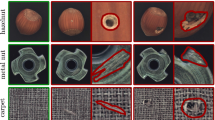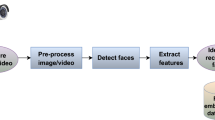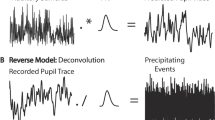Abstract
When switching to automatic output-quality testing systems, the aspiration for improving the detectability of insignificant deviations of the output parameters from the statutory ones necessitates the solution of a number of new problems. One of those is assessing the effect of the image-energy spectral density from an axisymmetric flaw on the reliability of its detection against background noise by both human and computer vision systems. Knowing this information is a necessary condition for developing new enhanced testing and evaluating techniques. Results are presented on the probabilities of false alarm and correct detection of axisymmetric circular or rectangular flaws depending on the signal-to-noise ratio (SNR) and the ratio of the flaw radius to the background-fluctuation correlation radius. It has been established that for small SNR, human vision is more effective than machine vision that implements the correlation detector algorithm and the Neyman–Pearson criterion.
Similar content being viewed by others
References
Barkhatov, V.A., Detection of signals and their classification with image-recognition methods, Russ. J. Nondestr. Test., 2006, vol. 42, no. 4, pp. 227–236.
Kirsch, R.A., Experiments in processing pictorial information with a digital computer, Proc. Eastern Joint Comput. Conf., 1957, pp. 221–229.
Plastinin, A.I., Khramov, A.G., and Soifer, V.A., Detecting Textured inhomogeneities in microscale images of materials, Komp’yut. Opt., 2011, vol. 35, no. 2, pp. 158–165.
Ozdemir, S., et al., l. Comparative evaluation of texture analysis algorithms inspection of textile products. Pattern Recognition, Proc. Foortenth Int. Conf., 1998, vol. 2, pp. 1738–1741.
Epifantsev, B.N. and Lyakhovskii, V.S., Detection of simply shaped objects on stationary images of an underlying surface by an interpreter/operator and by a computer vision system, J. Opt. Technol., 2016, vol. 83, no. 1, pp. 49–54.
Lowe, D., Distinctive image features from scale-invariant keypoints, Int. J. Comput. Vision, 2004, vol. 60, no. 2, pp. 91–110.
Zuo, W., Robust recognition of noisy and partially occluded faces using iteratively reweighted fitting of eigenfaces, Proc. Conf. on Advances in Multimedia information Processing, Lect. Notes Comput. Sci., New York: Springer-Verlag, 2006, vol. 4261, pp. 844–851.
Webb, A.R., Statistical Pattern Recognition, New York: Wiley, 2002.
Mellor, M., Locally potation contrast, and scale invariant descriptors for texture analysis, IEEE Trans. Pattern Anal. Mach. Intell., 2008, vol. 30, no. (1), pp. 52–61.
Epifantsev, B.N., Pyatkov, A.A., and Kopeikin, S.A., Multisensory systems for monitoring of restricted access territories: possibilities for a video analysis channel for detecting intrusions, Komp’yut. Opt., 2016, no. 1, pp. 121–129.
Epifantsev, B.N., Remote thermal-emission diagnostics for underground pipelines, Russ. J. Nondestr. Test., 2014, vol. 50, no. 3, pp. 154–163.
Abramovits, M. and Stigan, I., Spravochnik po spetsial’nym funktsiyam (Handbook of Special Functions), Moscow: Nauka, 1979.
Nosko, V.P., Local structure of Gaussian random fields near high-intensity flares, Dokl. Akad. Nauk SSSR, 1969, vol. 189, no. 4, pp. 714–717.
Epifantsev, B.N. and Lyakhovskii, V.S., Enhancing the efficiency of algorithms for detection of objects against mobile backgrounds, Part I, Vestn. Komp’yut. Inf. Tekhnol., 2013, no. 12, pp. 15–20.
Liu, X., et al., Measurement and analysis of perceivable signal-to-noise ratio for infrared imaging system with human vision, Proc. SPIE, 2012, vol. 8562-57.
Author information
Authors and Affiliations
Corresponding author
Additional information
Original Russian Text © B.N. Epifantsev, S.S. Zhumazhanova, 2017, published in Defektoskopiya, 2017, No. 1, pp. 57–65.
Rights and permissions
About this article
Cite this article
Epifantsev, B.N., Zhumazhanova, S.S. On the effect of the shape of a flaw on its detectability against noise background. Russ J Nondestruct Test 53, 62–70 (2017). https://doi.org/10.1134/S1061830917010053
Received:
Published:
Issue Date:
DOI: https://doi.org/10.1134/S1061830917010053




